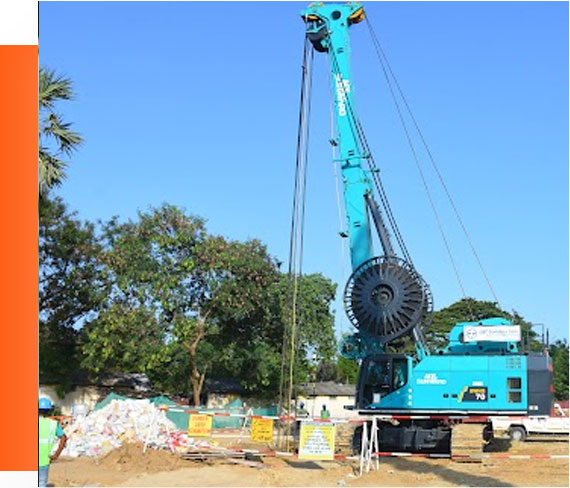
The Best form of retaining walls is the Diaphragm Wall system. Trench thickness from 400mm to 1500mm by 2500mm long. Trench depth up to 50 meters using 80 ton rig working capacity.
Diaphragm Wall is a cast in place with a reinforced or plain concrete retaining wall constructed by special designed trench equipment with multiple drill head or clamshell bucket. Diaphragm walls are underground structural elements commonly used for retention systems and permanent foundation walls. They can also be used as deep groundwater barriers The specialty in this method is to apply stabilizing fluid (bentonite slurry or polymer slurry) for preventing collapse of excavated trench.
Various types of excavation equipment can be used depending on project conditions, including hydraulic excavators or cable-hung clam buckets.
The sides inside the excavated trench can collapse easily. Bentonite slurry or Polymer slurry is used to protect the sides of the trench. Bentonite, a specially selected fine clay, when added to water, forms an impervious cake-like slurry with very large viscosity. The slurry will produce lateral pressure sufficient to retain the vertical soil. Diaphragm wall construction begins with the trench being excavated in discontinuous sections or "panels".
Placement of joining for the diaphragm wall panel - diaphragm wall cannot be constructed continually for a very long section due to limitation and size of the mechanical plant. The wall is usually constructed in alternative section. Two stop end tubes will be placed at the ends of the excavated trench before concreting. The tubes are withdrawn at the same time of concreting so that a triangular end section is formed. Wall section are formed alternatively leaving an intermediate section in between. The in between section are built similarly afterward but without the end tube. At the end a continual diaphragm wall is constructed with the panel section tightly joined by the triangular groove.
Reinforcement is inserted in the form of a steel cage, but may be required to lap a few sections in order to reach the required length. Once the excavation of a panel is complete, a steel reinforcement cage is placed in the center of the panel.
Placement of concrete is done using tremie pipes to avoid the segregation of concrete. As concrete is being poured, bentonite will be displaced due to its lower density than concrete. Bentonite is then collected and reused.
Concrete is poured in one continuous operation through one or more tremie pipes that extend to the bottom of the trench.